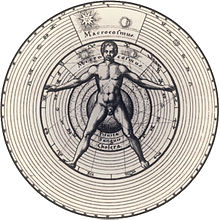宏觀與微觀



宏觀與微觀(Macrocosm and microcosm,或譯為大宇宙與小宇宙)是西方自古希腊、中世纪时代形成的一种观念,假定人类(小宇宙)与宇宙(大宇宙)之间存在结构相似性,因此,关于整个宇宙本质的真理可以从关于人性的真理中推断出来,反之亦然。在世界各地也存在类似的思想,如中国的天人感应、天人相应。
利用这种观念可以推出其他一些观念,包括宇宙可以被视为有生命甚至有灵魂(最早见于柏拉图《蒂迈欧篇》),后影响了斯多噶派。在医学和占星术上,行星也会被认为与人的某个器官或性格间存在关系。
根據學者皮爾·A·李法德(Pierre A. Riffard)所述,它是一個“在所有奧秘思想學派中出現(present in all esoteric schools of thinking)”的特徵。[2]它與赫耳墨斯主義(Hermeticism)密切相關並且基於諸如占星術、煉金術,以及神聖幾何(Sacred geometry)其前提是“如其在上,如其在下(As Above, So Below)”的實踐。[3]
註釋[编辑]
- ^ Robert Fludd in Utriusque Cosmic Historia, II; quoted by Pierre A. Riffard in Dictionnaire de l’ésotérisme, Paris: Payot, 1983, 34.
- ^ Pierre A. Riffard, Dictionnaire de l’ésotérisme, Paris: Payot, 1983, 34.
- ^ Antoine Faivre, Access to Western esotericism (页面存档备份,存于互联网档案馆), State University of New York Press, 1994, 10-11.
- Republic, Plato, trans. By B. Jowett M.A., Vintage Books, NY. § 435, pg 151
相關條目[编辑]
參考書目[编辑]
- Theories of Macrocosms and Microcosms in the History of Philosophy, G. P. Conger, NY, 1922, which includes a survey of critical discussions up to 1922.
外部連結[编辑]
- Cosmos - an Illustrated Dimensional Journey from microcosmos to macrocosmos-來自於Digital Nature Agency。
